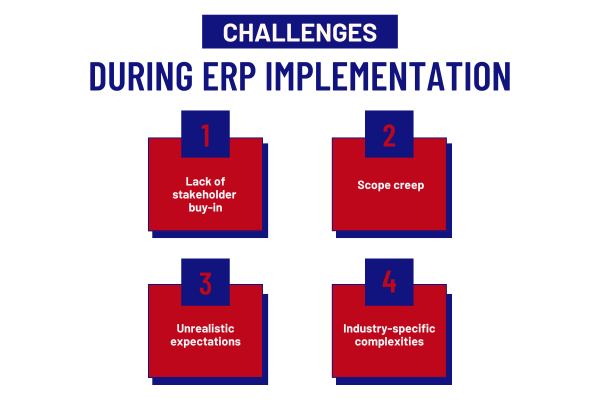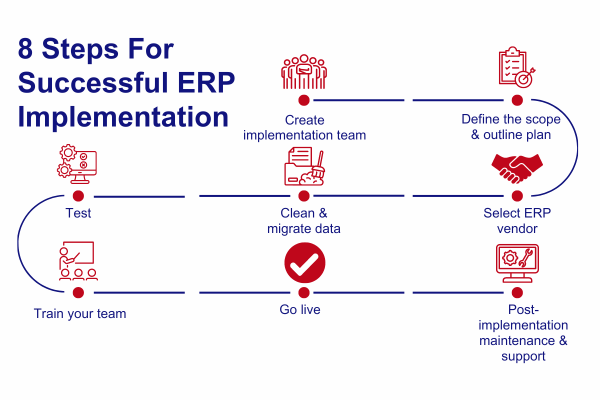Your fashion company needs to stay ahead of trends, manage inventory, and ensure seamless operations.
This requires more than just intuition; it demands sophisticated tools and systems.
An Enterprise Resource Planning (ERP) system tailored to the apparel industry can significantly enhance these aspects, making the choice of ERP software crucial.
This guide delves into a step-by-step approach to ERP implementation for your fashion company.
The ERP implementation journey is often fraught with challenges. Understanding and addressing these common pitfalls can significantly improve the success of your ERP project.

One of the most significant obstacles to successful ERP implementation is the lack of buy-in from key stakeholders. Without the support of executives, department heads, and end-users, the project may face resistance, limited engagement, and even outright opposition.
Scope creep occurs when the project’s requirements and goals expand beyond the initial plan. This can happen due to changes in business needs, additional features requested by stakeholders, or a lack of clear project boundaries.
Scope creep can lead to increased costs, extended timelines, and resource strain. It can also complicate the implementation process, leading to delays and dissatisfaction among users.
Unrealistic expectations about what the ERP system can deliver—whether in terms of functionality, timelines, or ROI—can lead to disappointment and dissatisfaction. Overestimating the system’s capabilities or underestimating the complexity of the implementation can cause significant issues.
Fashion businesses often have unique needs, such as managing seasonal inventory, tracking fashion trends, and handling diverse product lines. ERP systems not specifically designed for the fashion industry might struggle to address these complexities, leading to implementation challenges.
While ERP implementation seems daunting, when done right, and with the right vendor, it doesn’t have to be painful. Follow these steps to ensure a seamless transition.

An ERP implementation team is pivotal to the success of your project. This team should comprise individuals who understand both the technical aspects of ERP and the specific needs of your fashion company.
Key roles include:
If you can find an IT specialist who is also a fashion industry expert, it’s a win-win.
Clearly defining the scope and outlining a detailed plan helps set expectations, allocate resources effectively, and mitigate risks.
The first step is to evaluate current processes and identify areas for improvement. Then, define what you want to achieve with the ERP system, for example, better inventory management or improved reporting.
From there you can establish key milestones and deadlines for each phase of the implementation.
Choosing the right ERP software is critical to ensure that it aligns with your company’s needs and supports your business processes effectively.
Look for ERP systems with features tailored to the fashion industry, such as inventory management, order processing, design software, and supply chain integration. They also need to be able to grow with your business and integrate with existing systems.
The best way to know for certain if they are the right fit is by reviewing their track record and reviewing their client testimonials.
Data cleanliness and proper migration are essential to ensure the accuracy and reliability of your new ERP system.
Review and clean up current data to eliminate inaccuracies and delete unnecessary data. Then, format and structure data according to your new ERP system’s requirements.
Ensuring that your data is accurate, complete, and well-organized is essential for the successful operation of your ERP system. This process not only affects the efficiency of the new system but also its ability to deliver reliable insights and support your business operations effectively.
Thorough testing is crucial in the ERP implementation process as it helps identify and resolve issues before the system goes live, thus minimizing the risk of disruptions to daily operations.
During testing, it’s important to include both static data (such as fixed records and configurations) and dynamic data (such as transactions and user inputs) in each test cycle to ensure that all aspects of the system are thoroughly evaluated.

After each testing phase, carefully analyze the results, make necessary adjustments to address any identified issues, and then retest to confirm that the problems have been resolved. This iterative approach helps ensure the system performs reliably and meets all requirements.
Effective training is crucial for leveraging the full potential of your ERP system and ensuring that it supports your business operations efficiently.
Rather than only providing general training that covers basic functionalities and navigation, it’s essential to offer training that is tailored to the specific needs of different departments, such as design, production, and finance. This specialized training ensures that each department can utilize the ERP system in a way that aligns with their unique processes and requirements.
By investing in targeted and ongoing training, you enhance user proficiency, reduce errors, and maximize the overall benefits of the ERP system.
The go-live phase marks the official transition to the new ERP system. Proper planning and execution are key to a smooth transition.
Ensure all data is migrated, and the system is fully configured. Transition to the new system during a low-activity period to minimize disruptions.
Then, keep a close eye on system performance and user feedback during the initial period.
Post-Implementation Maintenance & Support
Ongoing maintenance and support are crucial to ensure the ERP system continues to meet your business needs and adapts to any changes.

Maintenance Tasks:
The right vendor will provide support services during implementation and after to keep you running smoothly.
By following these steps and leveraging the strengths of PolyPM ERP Software, your fashion company can achieve a successful ERP implementation that drives efficiency, improves operations, and supports growth.
PolyPM ERP Software stands out for its comprehensive features tailored specifically for the apparel industry, by people from the apparel industry. With capabilities designed to streamline production, manage inventory, and enhance customer relationships, it can provide significant advantages to fashion companies.